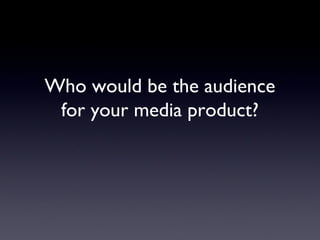
Evaluation Question 4
- 1. Who would be the audience for your media product?
- 2. My Media Product • I decided to make a product in the genre of social realism • This is a very small genre, it is very overlooked compared to more mainstream genres like action or sci-fi. • My research showed that only a small amount of people enjoy social realism, this means that the amount of social realism films is are significantly less than mainstream films
- 3. Cinema’s and Theatres• Many multiplex, mainstream cinema’s don't show social realism on a regular basis.They will show well known Hollywood films like, Comedy, drama and action etc. • For these types of cinema they are specifically targeting a younger target demographic, so the audience would want more mainstream films. • With social realism films, they are less likely to get into a multiplex cinema, this is because they are more forward with a intelligent and serious audience, this mean they will play in small independent cinema’s to allow the niche audience a venue.
- 4. Venues for Social RealismVenues• There are many specialised independent cinema’s who are willing to play films from the genre of social realism. • Some examples of these are,The National Film Theatre, London,The Harlequin, Redhill and The Arnolfini, Bristol. • These venues are for more media intellectual audiences, meaning they are usually based around other people who are linked to visual arts like Drama,Acting or Dance.
- 5. Streaming Online • As of late many online companies have been producing streaming companies.These are subscription companies that allow us to watch a variety of films, these include Netflix, Lovefilm and MUBI. • MUBI is very heavily based on social realism, it has a lot of films in the genre, this contrasts Netflix and Lovefilm these have very few social realism films and are based on the most mainstream ones like FishTank. • MUBI allows for views to watch older and more niche genres like social realism.These sites are for more dedicated film viewers and are for more serious films. • MUBI attracts more viewers by using a certain colour scheme to attract more serious views and repel more trivial viewers .This differs from netflix and lovefilm because they have bright colours and MUBI has dull colours. • On MUBI members have chatrooms and forums to allow viewers to focus on themes and issues in the films, these people are usually very intelligent and have a very large and deep knowledge of media.
- 6. Television • On BBC2 they had a seven week period to show films from different genres each week.Week 3 got dedicated to social realism.This means not only did they want to gain social realism viewers, they wanted to promote the genre itself to make it more well known.This may have turned some people away from social realism but it may have also piqued peoples interests intothe genre which ment it would gain viewers.
- 7. BBC Four • BBC Four is a very niche channel in itself, it regularly plays niche shows that target certain areas for specialised demographics. • It also plays 100 hours of new art and music programmes, 110 hours of factual programmes and 20 new international films. • This shows us the seriousness of the demographic BBC Four wants to target, they want very serious intellectual viewers.The seriousness of the channel may stop more mainstream audiences coming to the channel.This is very close to social realism and may lead too BBC Four playing social realism films and also targeting a similar demographic.
- 8. Film 4 • Film 4 is very versatile in what content is plays for its viewers.They show a mix of niche and mainstreams films to content all audiences.The bulk majority are Hollywood films but this fluctuates. • They also have times were they base there viewing around a certain topic, these includes themes, actors, directors and genres. • They are also linked with their own production company, this allows them to produce films and air them on there own channel.This also gives them recognition and publicity.This will help the audiences to trust their brand and want to watch films by them in the future. • This means they are targeting both niche and intellectual film watchers meaning that they have a range of audience which makes it more versatile in the future.
- 9. Radio • Radio stations such as BBC Radio 3, regularly show pieces linked to social Realism. • These are shown it correspondence with The Arts, Culture and Media. • They also allow adaptations, for example, the film ‘look back in anger’ was done in a radio show. • These are more suited to open-minded intellectuals with more creative and colourful minds.This style is similar to that of BBC Radio 4. • BBC Radio 3 & 4 tend to have older viewers, these viewers tend to hold these shows in high value.
- 10. Printed Media • This is a very niche category aimed at more literate intellectual readers.This includes the magazine Sight and Sound.They have a lot of film based content. This is done by Reviews, Screenshots, Credits, Interviews and News.This allows viewers to keep up to date and allow for Reviews to come out so they can decide what to watch etc. • We can assume Sight and Sound readers are very knowledgable in both, media and literature, so meaning this is for a very specified audience and will probably be very smart and the vocabulary will be very highbrow and specific to media as well as being very well written with very complex language.